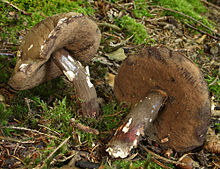Dark bolete
| Dark bolete | ||||||||||||
|---|---|---|---|---|---|---|---|---|---|---|---|---|

Gloomy boletus ( Porphyrellus porphyrosporus ) |
||||||||||||
| Systematics | ||||||||||||
|
||||||||||||
| Scientific name | ||||||||||||
| Porphyrellus porphyrosporus | ||||||||||||
| ( Fr. & Hök ) E.-J. Gilbert |
The gloomy or porphyry boletus ( Porphyrellus porphyrosporus , syn .: P. pseudoscaber ) is a species of fungus from the family of the swirling head relatives (Strobilomycetaceae). The gray-brown fungus is the only European representative of the genus, but some mycologists also count it among the bile tubers .
features
Macroscopic features
The hat of the dark bolete is 5–16 cm wide. It is initially hemispherical, then cushion-shaped and later flat and fleshy. The brim of the hat is pointed or curved downwards. The hat of young mushrooms is light gray-brown, later it becomes darker and takes on a dark gray-brown to olive-brown color. The surface is finely felted and velvety and has a matt, dry texture. The tubes are greyish-brown initially and take on a darker and dirtier hue over time. Pressure points become darker. Their length is 1–2 cm, they are attached or bulged and semi-free. The pores are gray-brown to black-gray and with age they are wide and angular. The stem of the dark bolete has a length of 5–15 cm, a thickness of 1.5–4 cm and the color of the hat. Its shape ranges from bulbous to cylindrical, sometimes club-shaped or cylindrical. The base is whitish and tomentose, the rest is velvety; pressure points change color here too. The meat is whitish or gray-white and initially firm and hard on the stem, later it becomes softer. When cut, it slowly turns bluish, reddish or greenish. Eating spots are white, the meat juice turns paper green. It smells sour to musty and sometimes has a bitter, but sometimes also mild taste. It can create a stinging aftertaste.
Microscopic features
The gloomy tube has smooth, spindle-shaped spores with a size of 13-20 × 6-8 µm . The spore dust is dark red-brown in color.
Species delimitation
At first glance there is a possibility of confusion with the chestnut boletus ( Imleria badia; syn. Xerocumus badius ). However, the gloomy Röhrling stands out due to its uniform dark brown color and its matt cap.
ecology
The gloomy boletus is a mycorrhiza- forming fungus that is mainly associated with conifers , more rarely with deciduous trees. Its preferred partners in Central Europe are Norway spruce and silver fir . Porphyrellus porphyrosporus occurs mainly in low mountain ranges , preferably in coniferous and mixed forests . The fungus can be found mainly in fir and beech stocks, but also in beech forests with a lime-poor soil from June to October. The occurrence is usually sparse, but in some places the dark boletus can also become a mass mushroom, for example in the temperate northern zone of Scandinavia .
distribution
The species is widespread in North America (from Canada to Tennessee) and in Europe eastwards to Asia, especially in the Caucasus it is common.
Systematics
External system
Porphyrellus porphyrosporus is the only species of the genus in Europe. It was first described in 1835 under the name Boletus porphyrosporus by Elias Magnus Fries .
Internal system
The following subspecies have been described for the dark bolete:
- Porphyrellus pseudoscaber subsp. cyaneocinctus
- Porphyrellus pseudoscaber subsp. pseudoscaber
- Porphyrellus pseudoscaber subsp. typicus
meaning
As an edible mushroom, the dark boletus is only edible to a limited extent due to its sometimes bitter-spicy taste. However, there is the possibility of using it to a certain extent as a mixed mushroom in mushroom dishes.
swell
literature
- Hans E. Laux: Edible mushrooms and their poisonous doppelgangers . Franckh'sche Verlagshandlung, W. Keller & Co., Stuttgart 1985. Page 10
- German Josef Krieglsteiner (Eds.), Andreas Gminder , Wulfard Winterhoff: Die Großpilze Baden-Württemberg . Volume 2: Stand mushrooms: inguinal, club, coral and stubble mushrooms, belly mushrooms, boletus and deaf mushrooms. Ulmer, Stuttgart 2000, ISBN 3-8001-3531-0 .
Individual evidence
- ↑ a b c d e Hans E. Laux: Edible mushrooms and their poisonous doppelgangers . Franckh'sche Verlagshandlung, W. Keller & Co., Stuttgart 1985. Page 10.
- ↑ a b c Porphyry tube in the natural dictionary , accessed on August 28, 2009.
- ↑ Porphyrellus porphyrosporus ( Memento from May 15, 2014 in the Internet Archive ) on www.first-nature.com, accessed on August 28, 2009.
- ^ Species Fungorum , accessed August 28, 2009.
- ^ Index Fungorum , accessed August 28, 2009.
Web links
- Frank Moser: porphyry bolete, gloomy bolete ( Porphyrellus porphyrosporus ). In: Natur-Lexikon.com . Retrieved September 2, 2012 .
- Boris Assyov: Porphyrellus porphyrosporus (Fr. & Hök) E.-J. Gilbert. In: boletales.com . Retrieved September 2, 2012 .



